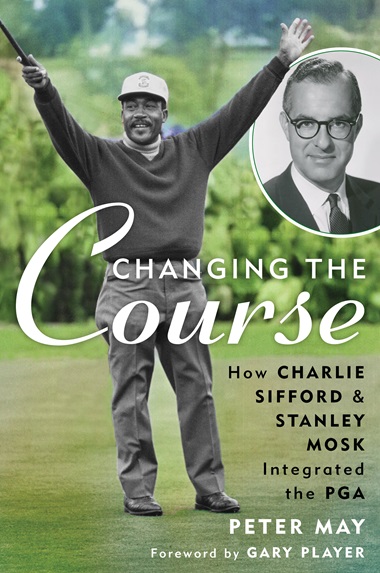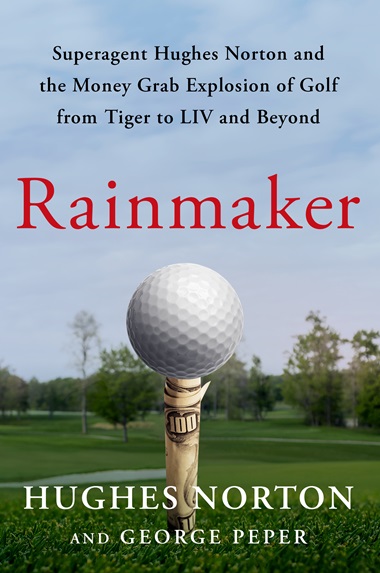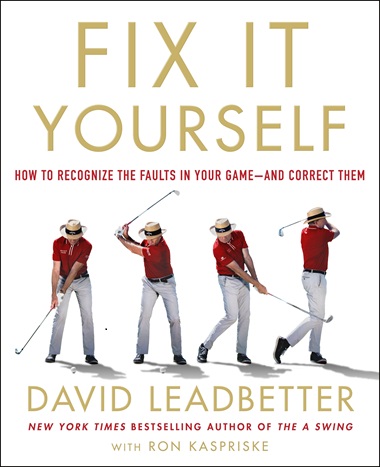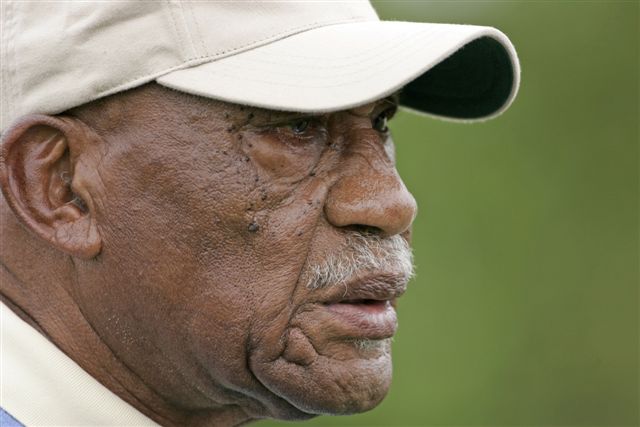It makes for a nice story when two men of disparate backgrounds come together to make the world a better place. And that’s just the story Peter May unfolds in his Changing the Course (Rowman & Littlefield, $29.95). The subtitle explains it all: “How Charlie Sifford and Stanley Mosk Integrated the PGA.”
 Most readers here will recognize the name of the late Charlie Sifford, the first Black golfer to get his PGA card. Fewer will know of Stanley Mosk, a California lawyer who became the state’s attorney general and later an associate on the state Supreme Court.
Most readers here will recognize the name of the late Charlie Sifford, the first Black golfer to get his PGA card. Fewer will know of Stanley Mosk, a California lawyer who became the state’s attorney general and later an associate on the state Supreme Court.
Sifford, who grew up poor in Charlotte, North Carolina, found his way to golf in 1934, when as a 12-year-old he began caddying at the Carolina Country Club (which accepted its first black members only ten years ago). The caddies could play on Mondays when the course was closed, and Sifford was soon enough shooting in the 70s. The club pro and owner were allies who urged him to move north where he could hone his game on integrated courses. Which indeed he did, particularly with backing from singer Billy Eckstine, winning his first tournament as a professional in 1951.
Turning professional for Blacks in those days meant playing in UGA tournaments (originally the United Colored Golf Association), functioning not unlike the Negro Leagues in baseball alongside the whites-only professional leagues. The difference being that Jackie Robinson broke baseball’s color line in 1947, whereas the PGA established its “Caucasians Only” clause in 1943. It wasn’t eliminated until 1961, the last mainstream sport to tear down the barriers of segregation.
It was in September 1959, that Mosk, then the California attorney general, was playing tennis at the Hillcrest Country Club. At some point, Eckstine introduced Sifford to Mosk, who was surprised and appalled to hear about the Caucasians Only rule and that Sifford was not a member of the PGA.
It’s not much of a spoiler alert to say that wheels started rotating furiously at that point, that Sifford would break professional golf’s color barrier, that he would eventually win two events on tour, and that he would be enshrined in the World Golf Hall of Fame.
Peter May, whose The Open Question (reviewed in the June-July 2021 issue) took on the controversy over how many U.S. Opens Ben Hogan won, here weaves the stories of Sifford and Mosk together in compelling, mostly alternate chapters, the worlds of golf and politics shooting sparks off each other. There are countless asides and fascinating tidbits in May’s book, but it’s a fast-paced and brisk narrative in how both men were able to do away with what Mosk rightfully called “the obnoxious restriction.”
<<<>>>
An agent of a different sort is the subject of Rainmaker by Hughes Norton and George Peper (Atria Books, $28.99). Besides its one-word title, the book is in the running for longest subtitle of the year: “Superagent Hughes Norton and the Money Grab Explosion of Golf from Tiger to LIV and Beyond.”
 Most golf fans are familiar with the tale of how the late Mark McCormack began his sports marketing agency IMG—now calling itself a global sports and culture company—with a single client, in a deal sealed with a handshake. It became known as the Golden Handshake, because the client was Arnold Palmer. The deal turned out well for both.
Most golf fans are familiar with the tale of how the late Mark McCormack began his sports marketing agency IMG—now calling itself a global sports and culture company—with a single client, in a deal sealed with a handshake. It became known as the Golden Handshake, because the client was Arnold Palmer. The deal turned out well for both.
It turned out well for Hughes Norton, too, at least until it didn’t. Though Norton has a co-author here, it’s a first-person account of his rise to the very heights within the agency, and then his abrupt fall. Norton was 25 and fresh out of Harvard Business School when he began working for McCormack in 1972. He would go on to represent a hit parade of PGA Tour pros, but none so sparkling, or problematic, as Greg Norman and Tiger Woods.
It was Woods who eventually—and to this day, mysteriously—pulled the plug on Norton, hastening the latter’s firing from IMG in late 1998. Why write the book now? Norton felt the life of sports agency has been caricatured by Hollywood (“Jerry Maguire,” “Air”), and that no one has penned a history of IMG from its beginnings as “the mom-and-pop operation it was when I began my career to the multibillion-dollar juggernaut it is now.”
So there are a lot of juicy tidbits in here, and money flies around like snow in a blizzard. Norton outs his roster of good guys—players like Curtis Strange, David Graham, Peter Jacobson, sportscaster Jim Nantz and Titleist’s Wally Uihlein. But he spares no love for the villains of the piece, agent Alastair Johnson, Nike’s Phil Knight, his one-time client Mark O’Meara who may have convinced Tiger to sever ties with Norton. As for Norman, he concedes having some wonderful times with him, but calls him, “…a classic narcissist.”
McCormack, and Tiger, fall somewhere in the middle. And Norton doesn’t exempt himself from judgment. He loved his job, had a million-dollar salary, was living a jet set life. But he was also a divorced workaholic with more enemies than friends. It took a long time, but he now sees his firing as redemptive.
He’s living a comfortable and seemingly more serene and balanced life. But Rainmaker certainly sounds wistful at times, and one can’t help noticing that he lives in Chagrin Falls, Ohio. With his hindsight, one also can’t help but heed Norton’s cautionary note: “… as proud as I was at the time that I earned Tiger an unprecedented $100 million in endorsement income, I see now that I was literally an agent of the wretched excess that pervades the game today…. Professional golf, if it isn’t careful, may well become a victim of its own greed.”
<<<>>>
And then there’s the most troublesome thing of all—your golf swing. But have no fear, David Leadbetter is back with Fix It Yourself: How to Recognize the Faults in Your Game—and Correct Them (St. Martin’s Press, $30), written with Ron Kaspriske.
 Leadbetter has been at this a long time, and the man just can’t stop himself from teaching. In a review of his The A Swing, I mentioned a dinner I was once at with a few other golf writers in Bradenton, Florida, at the Concession Golf Club. Leadbetter was at our table, and before the night was over he had us all taking cuts, trying to show us the theory behind that very book he was then working on.
Leadbetter has been at this a long time, and the man just can’t stop himself from teaching. In a review of his The A Swing, I mentioned a dinner I was once at with a few other golf writers in Bradenton, Florida, at the Concession Golf Club. Leadbetter was at our table, and before the night was over he had us all taking cuts, trying to show us the theory behind that very book he was then working on.
This latest effort is a soup to nuts catalog of everything you’re doing wrong, from your grip to your stance to the way you turn (rather than coil) your body to the way your set up with your putter (or driver or wedge or…) to your poor practice habits to your shoddy sand play, and let’s wrap it all up with your suspect mental approach.
It’s enough to give you a complex, I tell you! Well, right from the get-go Leadbetter suggests this is probably not a book to read cover to cover, at least not the first time around. He has chosen the “great golf number” of 72 faults to ponder, but he also provides 72 fixes—usually with some kind of drill to try—and 72 concise swing thoughts to encapsulate each one.
I think there might be more than 72 things wrong with my golf swing, but I’m willing to start somewhere.
“Please only work on one fault at a time from each section,” Leadbetter cautions, otherwise, “I’ll have to recommend a good mental health book for you….” He naturally suggests using the table of contents to zero in on whatever ails one. So naturally I turned immediately to Fault No. 33, “Worrying about the sha—.”
 Leadbetter throws caution to the wind and goes on to actually name this fault. But he says there’s a fix, and it will “send this demon back to hell.” That alone should be worth the price of admission.
Leadbetter throws caution to the wind and goes on to actually name this fault. But he says there’s a fix, and it will “send this demon back to hell.” That alone should be worth the price of admission.
This piece originally appeared in the April-May 2024 issue of Golf Oklahoma, in somewhat different form.

